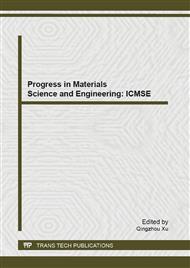p.610
p.616
p.621
p.626
p.632
p.639
p.645
p.650
p.655
The Creep Behavior of Wood-Polymer Composites
Abstract:
The creep behavior of WPCs needs to be addressed when developing and using this kind of materials. In this paper, the creep behavior of WPCs under linear viscoelastic region was investigated at different temperatures and bamboo flours levels. The creep compliance increase with the rise of temperature, the addition of bamboo flour has a positive effect on the creep behavior. Burgers model, Findley power law and TTSP were used to predict the long-term behavior of this kind material. Finely power law can well describe the creep properties of WPCs while Burgers model begins to diverge from measured data at about 100min. The application of TTSP was used to create master curve covered more than 108 from 30-min short-term creep compliance curves.
Info:
Periodical:
Pages:
632-638
Citation:
Online since:
October 2013
Authors:
Keywords:
Price:
Сopyright:
© 2013 Trans Tech Publications Ltd. All Rights Reserved
Share:
Citation:


